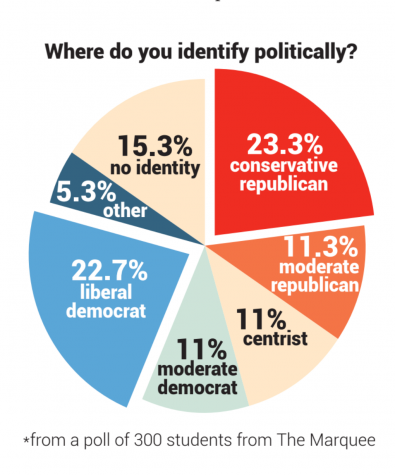Division between parties
October 30, 2020
The divide between political parties is greater, leaving less Independents with the upcoming presidential election. This division is seen on campus as well. Almost the exact same percentage of students identified as Democrats and Republicans at about 23 percent. The proportion of students who considered themselves moderates on both sides was also about the same at about 11 percent.
Junior Avery Hamilton, who identifies as a Conservative, agrees that the split between political parties is becoming more clear.
“America is supposed to be about freedom,” Hamilton said. “Liberty to choose what you want, and think what you want and be able to talk about things, honestly with almost no filter… but I feel like because everybody’s so one side or another, we’re definitely becoming more divided.”
AP Government teacher Carey Petkoff has seen this divide in her classes. Petkoff said that the even split between right-leaning and left-leaning students is unique compared to her classes two years ago.
“I had a heavy skew to the liberal side,” Petkoff said. “Sometimes I do activities where we break up into segments and I’ll do the ideology split, and I almost couldn’t do it because I had so few conservative students. But this year, it’s really not like that at all. I’ve really had a 50/50 in all three of my classes.”

Denton County is often considered a Conservative county in a historically red state. However, studies have shown that younger voters are more likely to be left-leaning. Petkoff said this could contribute to the even split seen on campus.
“The income level plays into party politics, as does race,” Petkoff said. “If you’re living in an area like ours that is largely affluent, that has traditionally been a part of the Republican base, you’re seeing a shift all over the place on both sides now where you have folks that are making more income that are skewing to the left.”
Senior Susanna Soelberg, who identifies as a Liberal Democrat, said she was surprised by the current split between political views in the local area.
“It’s more evenly split than I would have thought,” Soelberg said. “I honestly would have thought it would be more Conservative.”
Although many students identify with one end of the political spectrum, Petkoff said that she still has a considerable amount of moderate and apolitical students. In the poll, 11 percent identified themselves as Centrists, while about 15 percent said they had no identity. Petkoff believes that being socially liberal and economically conservative is a common trend among teens.
“It’s not necessarily that you don’t identify as Democrats or Republicans, but that your viewpoint on certain issues doesn’t necessarily lend itself to like one or the other,” Petkoff said.
Senior Matthew Hill, who considers himself a Conservative, thinks that the small number of apolitical students have maintained their views since the last election.
“They don’t want to be involved because all they see is fighting, and so they don’t want to have to join either side and then fight against the other,” Hill said. “So apolitical people, I don’t think they’ve really been drawn into it. I think they’ve sat out.”
Although senior Carson Fisher said his political views align more with liberal ideas, he tries to keep a moderate stance, as he sees value in having an open mind.
“I think anyone who doesn’t listen to both sides is foolish,” Fisher said. “I think that’s an immature stance to only align yourself with one side. I think both sides have valuable opinions and valuable information.”